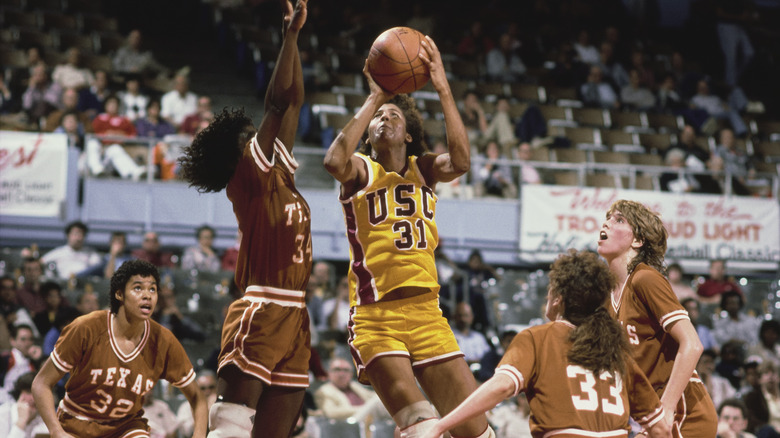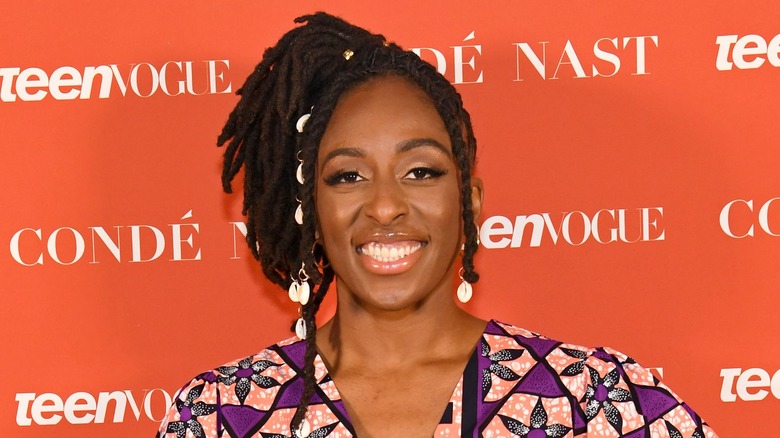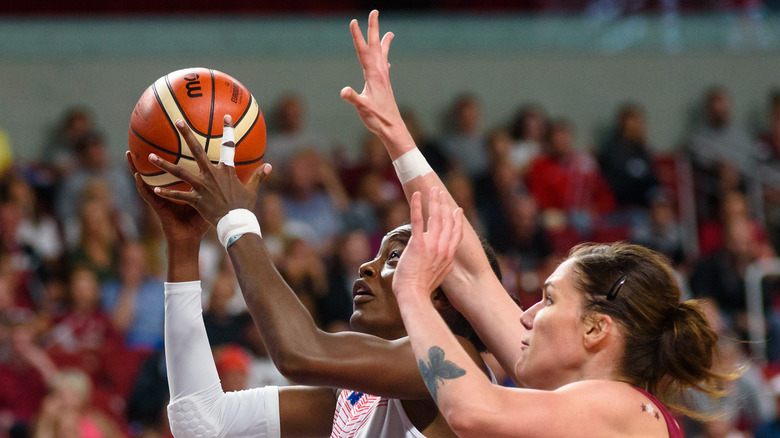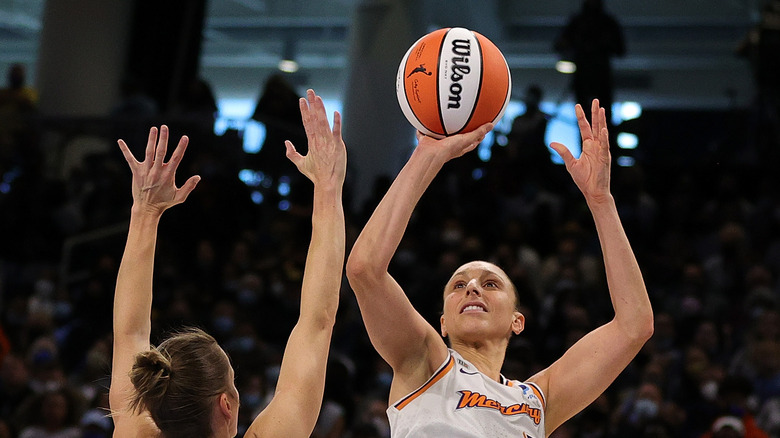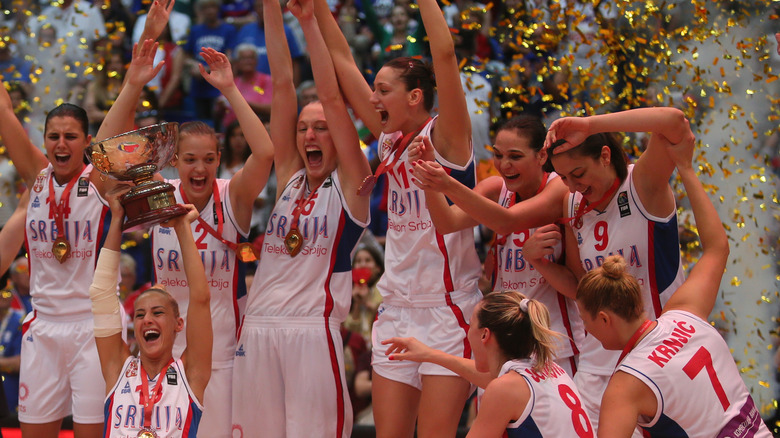The Real Reason So Many WNBA Players Play Overseas
The opportunity for women to play the game of basketball professionally in the United States has only grown since the formation of the Women's National Basketball Association (WNBA) in 1997, per Britannica. But with only 12 teams in the WNBA (versus 30 in the NBA), chances for women to realize their dream of playing pro ball on the hardwood remain limited in the U.S (via the NBA website). What's more, pay and other benefits between the men's and women's basketball leagues are far from equitable, as Yahoo! Finance reports.
All this leads female basketball players to look overseas for more opportunities to play the game they love and be paid what they're worth while they do it. But why exactly are female basketball players paid a higher salary in foreign countries, and precisely how much more do they make? Crucially, what will it take for U.S. teams to offer a better and more equitable balance between male and female pro basketball players? Answer these questions, and more U.S. teams may keep talented female athletes playing stateside.
History of Women's Basketball in America
Women's professional basketball came to the United States relatively late, even though women have played the game since at least the late 19th century, per the WNBA website. When professional women's ball came to the U.S., teams were at first limited to cities that already had an NBA franchise. Eventually, though, the league was allowed to branch out to cities without a men's team. Adding a pro women's basketball team to the U.S. is without a doubt progress, but women's pay lagged from the start, and not just in terms of annual salary.
WNBA players typically share less than half of the team revenue received by NBA players, according to Ebony. Per Deseret News, this could simply be economics: The WNBA season is shorter, and in general, the game draws far fewer eyeballs than the rival male league. Still, some believe there's no other way to explain the disparity than sexism. Point guard Skylar Diggins-Smith from the WNBA franchise Dallas Wings said (via Ebony), "People try to hijack this issue and say that women's basketball may not be as interesting a game, because they disparage women in sports, period."
Playing for change
Although much improvement still needs to be made, there is evidence that pay and overall working conditions are improving for professional female basketball players in the U.S. In 2020, for example, a new collective bargaining agreement (CBA) was announced by WNBA commissioner Cathy Engelbert and WNBA president Nneka Ogwumike, according to FanBuzz. Under the new agreement, salaries were bumped considerably for both rookie and veteran players. (Ogwumike is pictured above.)
Other positive developments related to the new WNBA CBA include better traveling accommodations for the players, the potential for higher league revenue sharing, and fully paid maternity leave. Though pay for a superstar is still far less than their male counterpart under the new CBA, WNBA Commissioner Engelbert applauded the development, telling WGN in Chicago, "The CBA guarantees substantial (financial) increases. The way we are paying these players is different than the past."
Pay is still better overseas
Just how much better do female basketball players get paid in foreign countries? Per the Associated Press, the average female basketball player in the U.S. makes $130,000 dollars a year, far less than the average NBA salary of nearly $8 million and growing (via Run Repeat). A salary of $130,000 may sound like a lot, but for context, that's less than what the average IT manager makes and about the same salary as a dentist, per U.S. News & World Report.
What's more, few WNBA players join overseas teams for good. Instead, they pull double duty: playing for a WNBA team during the season and then head overseas to do it all over again, sometimes just to pay their bills. According to Christie Rogers, a Radford University women's assistant coach who interned with the WNBA's Washington Mystics (via Global Sport Matters): "I worked for the Mystics in 2008, and our whole team played overseas. When training camp started in April and May, some of the players weren't even back yet."
Follow the money
WNBA players and female basketball players seeking better pay and more opportunity often find themselves in Russia and Ukraine. That's not solely because team owners are necessarily more enlightened about gender equity in sports — it also has a lot to do with team ownership, according to the Associated Press. In Russia and Ukraine, women's basketball teams are often government-owned or subsidized or owned by oligarchs for whom money is no object when compared to the bragging rights of winning a championship.
Per the Associated Press, owners in Russia and Ukraine are also known to treat their players with gifts, bonuses for personal spending, and higher-end accommodations. Notably, in Russia, there's no salary cap, player's union, or collective bargaining agreement. In 2015, WNBA star Diana Taurasi, who played for Russia's UMMC Ekaterinburg, said, "We had to go to a [formerly] communist country to get paid like capitalists, which is so backward to everything that was in the history books in sixth grade." (Taurasi is pictured above.)
A world of possibility
Of course, money is just one factor — paychecks aside, many female American basketball players join teams overseas simply because there are many more teams to play for, according to FIBA, the international basketball association. Per FIBA, women's basketball worldwide is divided into five zones and over 213 national federations. "We establish the official basketball rules as well as the regulations that govern the relationships between the different members of the basketball community," the site reads.
What's made plain by these numbers is that if a talented female basketball player can't earn a spot on an American WNBA team, chances are there's an open position on a team based outside the U.S. There are even more opportunities for women to play basketball in a foreign country than to play soccer, which is commonly thought of as an international sport played much more often by women. For example, international football's governing body, FIFA, recognizes less than 200 women's soccer teams worldwide.

